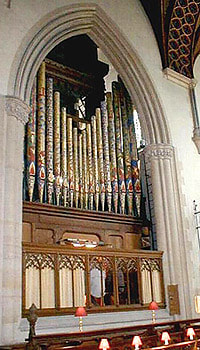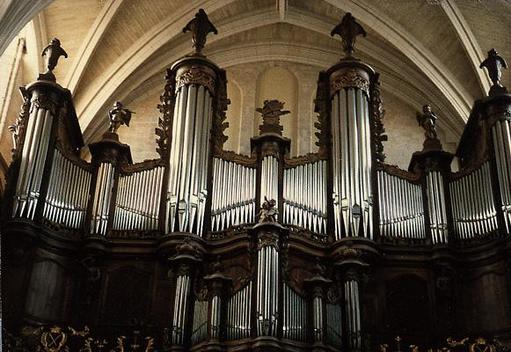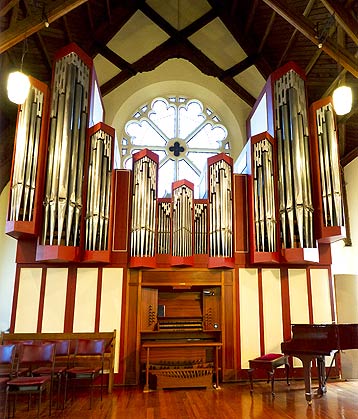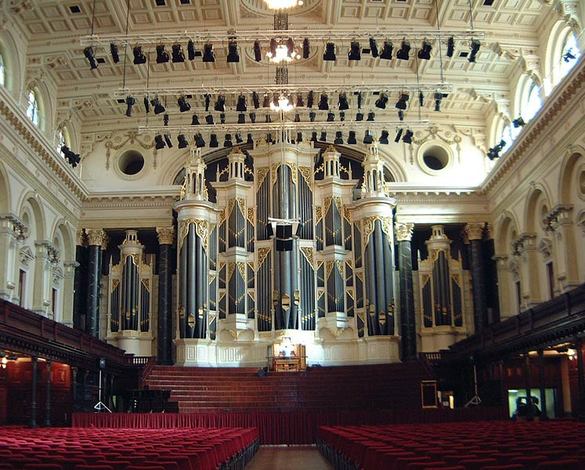David Bridgeman-Sutton muses about organ cases - big and small, old and new.
The fourth item in this series.
The fourth item in this series.
Organ Cases 4
“Father” Henry Willis would tell clients that money was better spent on stops than on cases. His large 4-manual organ at St Michael’s, Tenbury, Worcestershire, (picture 1) presents to the world a face of Reich-like minimalism.
|
Practically, the arrangement of the front pipes leaves a lozenge-shaped space for the escape of sound from a rather crowded organ chamber.
Willis usually provided adequate cases for his Town Hall organs. These were not, perhaps, quite of the standard his descendants reached, for instance at Liverpool and Dunedin cathedrals ~ the latter of which was, alas, destroyed in the 1960s. The organ in the cathedral in Bordeaux (picture 2) illustrates several distinctive features of many French cases. It occupies the full width and most of the depth of the West gallery. This gives space for pipes to speak ~ an advantage which French builders tend to use to the full ~ while reflections from stone walls and vaulting help to project tone into the building. |
The overall effect is horizontal, unlike the vertical emphasis of many of the great organs of Holland and North Germany (e.g. Haarlem).
This horizontal line might have led to an ungraceful “dumpiness”. The ways in which this effect is avoided is interesting. The smaller positif case is bracketed out from the gallery at a slightly lower level, thus adding to overall height; display pipes are of small scale (i.e. narrow in relation to their height) ; and the number of towers (seven) and flats (six) in the main case ensures that none is unduly wide, again helping to emphasise height rather than width. Silvered pipes are another common French feature.
This horizontal line might have led to an ungraceful “dumpiness”. The ways in which this effect is avoided is interesting. The smaller positif case is bracketed out from the gallery at a slightly lower level, thus adding to overall height; display pipes are of small scale (i.e. narrow in relation to their height) ; and the number of towers (seven) and flats (six) in the main case ensures that none is unduly wide, again helping to emphasise height rather than width. Silvered pipes are another common French feature.
|
In Bordeaux, the windows behind the organ are blind. In many churches, they are glazed, sometimes filled with superb stained glass. In order not to block light , cases may then be arranged with an upper outline that is lowest in the middle. A good example of this occurs at St Semin's basilica, Toulouse. Compare Croft's treatment in the similar situation at Rugby Street Methodist Church, Christchurch.
Two further points: In their cases, French builders often give full rein to the national love of carving and statuary - note the urns, finials and figures at Bordeaux and Toulouse, which also add to the effect of height. It is often hard to see or photograph such details when they are high in the roof and backlit as well. |
Finally, one of the world's superb organs in an equally superb Town Hall - Sydney. This photograph shows how the case suits the classically-inspired architecture of the hall. It is a joy to contemplate: note the smaller 'pavilions' at the sides and the pillared-canopy finials to the towers: (pity about those loudspeakers, though!).
The Hill case might never have been made: the story is on the Sydney Town hall website.
Hill, the builders, produced numerous worthy cases: a member of the family, Arthur Hill, made one of the first serious studies of organ cases: his books, illustrated with his meticulous drawings are elusive; copies have been eluding me for over 50 years. What kind of case might Tenbury have if Hill and not Willis won the contract for that instrument?
The Hill case might never have been made: the story is on the Sydney Town hall website.
Hill, the builders, produced numerous worthy cases: a member of the family, Arthur Hill, made one of the first serious studies of organ cases: his books, illustrated with his meticulous drawings are elusive; copies have been eluding me for over 50 years. What kind of case might Tenbury have if Hill and not Willis won the contract for that instrument?
David Bridgeman-Sutton,
Jan 11, 2003
Jan 11, 2003
Acknowledgements:
Picture 1: Copyright: the British Institute of Organ Studies 2000
Pictures 2 & 3: Copyright: Jenny Setchell
Picture 1: Copyright: the British Institute of Organ Studies 2000
Pictures 2 & 3: Copyright: Jenny Setchell





